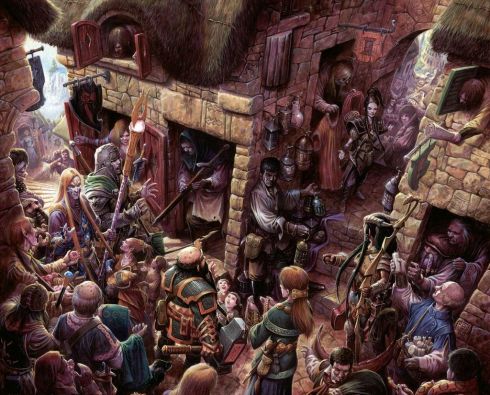Urban (range)
Urban ranges are densely settled areas relating to concentrated towns or cities, and with few exceptions, villages as well. The dwellers in urban ranges work primarily on non-agricultural tasks; while some settled population areas include orchards or fields located inside their environs, these parts are correctly thought of as rural and not urban. Urban describes dense streets, buildings, drainage for sanitation and masonry for defense and managing the population.
Urban ranges are built to take in tremendous supplies of food and materials for consumption and manufacturing, the latter being transported outwards. Cities and towns resemble a great bellows, with the movement of ships, boats and wagons flowing in and out. Quays, docksides along rivers and large holding areas collect stores of goods that are sheltered beneath awnings or within great storehouses — which may overflow, depending upon the produce and which season it is, into the streets. This is especially true of agricultural produce, which pours into the urban center more quickly than it can be transshipped outwards again.
The urban center also serves as an administrative and defensive bulwark of the province or kingdom — and so a substantial portion of the population relates to accounting, decision-making and maintaining order (not only of the urban space but also its environs). Authority is far from centralized; it is divided between nobles, military orders, guilds, cabal and religious entities, each of whom liaison with one another while subtly vying for control of the urban center's people and wealth. This competition for power descends through the strata of the inhabitants, so that factions grapple for control of neighbourhoods, markets and even the streets themselves, marking off territories and jealousy defending their dominance. Status-seeking incorporates a quest for allies and trusted henchmen, while isolating, negating or eliminating one's enemies.
Conditions
If the characters have money, urban ranges are the safest places anywhere. Characters can choose to take a private room in a luxurious inn, prestigious rooms in an apartment block or even purchase their own house. So long as they remain upon avenues and among the hoi polloi, they may count on guards, social conventions and the presence of powerful acquaintances to ensure a life of refinement and peace. On a lesser scale, they may live among the bourgeoisie, less elegant but by no means uncomfortable or perilous. It is only in the slums and among the criminal element that the players need fear anything. In market towns, every object of one's desire can be purchased or at least sent for, though this may take hiring agents and the desired object may take months to arrive. In the meantime the character can dine, drink, study, learn a trade, operate a business, speculate, participate in politics or any of a hundred other activities ... so long as the money lasts.
Common Features
Below is a list of elements and features that are common to savanna ranges:
- Almshouse
- Apothecary
- Aqueduct
- Archery Range
- Arena
- Armoury
- Arsenal
- Avenue
- Bailey
- Bank
- Barracks
- Baths
- Black Market
- Bollard (see notes)
- Bridge
- Carter Post
- Castle
- Cathedral
- Combat Pit
- Courthouse
- Courtyard
- Court (space)
- Dry-dock
- Dump
- Fairs & Festivals
- Ferry
- Fishpond
- Flophouse
- Forge
- Fountain
- Garden
- Gong Pit
- Granary
- Graveyard
- Grocery
- Guardpost
- Guildhouse
- Harbour Tower & Spur
- Harbour
- Hospital
- Hostel
- Inn
- Keep
- Laboratory
- Lane
- Lavatory (see notes)
- Library
- Memorial
- Mews
- Mint
- Money Lender
- Monument
- Neighbourhood
- Office
- Palace
- Pharos
- Poster (see notes)
- Private Chapel
- Public Art
- Quarter
- Rat Catcher
- Reservoir
- School
- Sewer
- Shanty
- Slum
- Solar Observatory
- Stable
- Statue
- Stockyard
- Street Market
- Street Sign (see notes)
- Street
- Streetlamp (see notes)
- Tavern
- Temple
- Thaumaturgical School
- Theatre
- Tower
- Town Hall
- Town Wall
- University
- Villa
- Warehouse
- Well
- Workhouse
- Workshop
Urban Creatures
The following monsters are common to urban areas:
See List of Ranges
